Students can find that CBSE Previous Year Question Papers Class 10 Science with Solutions and CBSE Class 10 Science Question Paper 2019 (Series: JMS/4) effectively boost their confidence.
CBSE Class 10 Science Board Question Paper 2019 (Series: JMS/4) with Solutions
Time allowed: 3 hours
Maximum marks: 80
General Instructions
- The question paper comprises five sections A, B, C, D and E. You are to attempt all the sections.
- All questions are compulsory.
- Internal choice is given in sections B, C, D and E.
- Question numbers 1 and 2 in Section A are one mark questions. They are to be answered in one word or in one sentence.
- Question numbers 3 to 5 in Section B are two marks questions. These are to be answered in 30 words each.
- Question numbers 6 to 15 in Section C are three marks questions. These are to be answered in about 50 words each.
- Question numbers 16 to 21 in Section D are five marks questions. These are to be answered in 70 words each,
- Question numbers 22 to 27 in Section E are based on practical skills. Each question is a two marks question. These are to be answered in brief.
SET – I Code No. 31/4/1
Section – A
Question 1.
Define Resistance. Give its S.I. unit.
Answer:
Resistance is the property of a conductor to resist the flow of current through it.
Its S.I. unit is ohm, represented by the Greek letter Ω (omega).
Question 2.
Name the pigment present in the red blood cells which transports oxygen in the human beings.
Answer:
Pigment present in the red blood cells which transports oxygen in the human beings is haemoglobin.
Section – B
Question 3.
State laws of reflection of light.
OR
Define absolute refractive index and express it mathematically.
Answer:
The laws of reflection are:
(i) The angle of incidence is equal to the angle of reflection.
(ii) The incident ray, the reflected ray, and the normal at the point of incidence all lie in the same plane.
OR
The ratio of the speed of light in air or vacuum to the speed of light in any medium is called the absolute refractive index.
If ‘c’ is the speed of light in air and v is the speed of light in the medium, then the refractive index of the medium is given by
Refractive Index (η
m
) = \(\frac { speed of light in air }{ speed of light in the medium }\) = \(\frac { c }{ v }\)
![]()
Question 4.
Draw magnetic field lines around a bar magnet.
Answer:
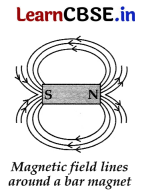
Question 5.
What happens when 5% alkaline potassium permanganate solution is added drop by drop to warm propyl alcohol (propanol) taken in a test tube? Explain with the help of a chemical equation.
Answer:
During this reaction the alcohols are converted into carboxylic acids as carbon compounds can be easily oxidised. Therefore, when propanol is heated with alkaline potassium permanganate solution, it gets oxidised to propanoic acid. The colour of the potassium permanganate does not disappear as it is used to oxidise alcohol to acids.

Section – C
Question 6.
Draw the ray diagram for the following cases:
(i) Object placed between P and F points of a concave mirror.
(ii) Object placed at a distance equal to ‘C’ point in front of a convex mirror.
Answer:
(i) When the object is placed between P and F – the two reflected rays (one passes through the focus and the other retraces through centre of curvature) are diverging and appear to meet in backward direction. This produces a virtual and erect image.
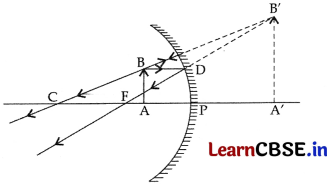
(ii) Convex mirror always forms an erect, virtual and diminished image for all positions of the object placed in front of it.
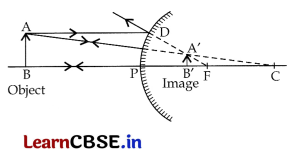
Question 7.
What is the cause of dispersion of white light through a glass prism? Draw a ray diagram to show the path of light when two identical glass prisms are arranged together in inverted position with respect to each other and a narrow beam of white light is allowed to fall obliquely on one of the faces of the prisms.
OR
What is scattering of light? Use this phenomenon to explain why the clear sky appears blue.
Answer:
The phenomenon of splitting of white light into seven colours on passing through a glass-prism is called dispersion of white light. Refraction of light is the cause of dispersion of white light into its seven component colours by a prism.
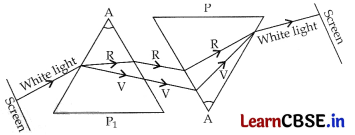
The dispersion of white light occurs because colours of white light travel at different speeds through the glass prism. Different colours of light bend through different angles with respect to the incident ray as they pass through a prism.
OR
The phenomena of change in the direction of propagation of light caused by the large number of molecules such as smoke, tiny water droplets, suspended particles of dust and molecules of air present in the earth’s atmosphere is called scattering of light.
The colour of the scattered light depends on the size of the scattering particles in the atmosphere.
- The larger particles of dust and water droplets present in the atmosphere scatter the light of longer wavelengths due to which the scattered light appears white.
- The extremely minute particles such as air molecules present in the atmosphere scatter mainly blue light present in the white sunlight.
Colour of the sky appears blue. The molecules of air and other fine particles in the atmosphere have a size smaller than the wavelength of visible light. So these particles scatter more effectively the light rays of shorter wavelength at the blue end than light of longer wavelength at the red end. When the scattered blue light enters our eyes, it gives us the feeling of a blue sky.
Question 8.
(a) Classify the following reactions into different types:

(b) Translate the following statement into a balanced chemical equation:
“Barium chloride reacts with aluminium sulphate to give aluminium chloride and barium sulphate.”
OR
When potassium iodide solution is added to a solution of lead (II) nitrate in a test tube, a precipitate is formed.
(a) What is the colour of this precipitate? Name the compound precipitated.
(b) Write the balanced chemical equation for this reaction.
(c) List two types of reactions in which this reaction can be placed.
Answer:
(a) (i) Double displacement reaction
(ii) Combination reaction
(iii) Decomposition reaction
(iv) Displacement

OR
(a) The precipitate is yellow in colour. It is lead iodide (Pbl
2
).
![]()
(c) (i) Double Displacement Reaction; (ii) Precipitation Reaction.
Question 9.
(a) Natural water bodies are not regularly cleaned whereas an aquarium needs regular cleaning. Why?
(b) What are decomposers? What will be the consequence if the decomposers are completely
eradicated from an ecosystem? Give justification in support of your answer.
OR
How is ozone formed in the upper atmosphere? State its importance. What is responsible for its depletion? Write one harmful effect of ozone depletion.
Answer:
(a) An aquarium is an artificial and incomplete ecosystem compared to natural water bodies which are self sustaining and complete ecosystems where there is a perfect recycling of material. In a pond or lake, the waste produced serves as the food material for the decomposers and is thus eliminated by them from the water. Whereas in an aquarium, the uneaten food and waste generated mixes with the water due to the lack of decomposers. Therefore it needs to be cleaned.
(b) The microorganisms like bacteria and fungi which breakdown the complex organic substances into simple inorganic substances that go into the soil and are used once more by the plants are called decomposers. If all the decomposers were eradicated from the ecosystem, then there will be no agency to decompose dead bodies of animals and plants. They would start giving foul smell and it would become impossible to live on the earth. It is the decomposers who help to replenish the soil by their conversion of organic into inorganic compounds. In the absence of decomposers, natural replenishment of soil does not take place.
OR
Ozone is formed in the upper atmosphere by the reaction of ultraviolet (UV) radiations on oxygen (O
2
) molecules. Importance. The ozone layer acts as the ozone shield over the surface of the earth and absorbs the harmful ultraviolet radiations of the Sun and prevents them from reaching the earth’s surface.
The damaging effect of CFCs (Chlorofluorocarbons) is responsible for the depletion of ozone layer. Harmful effect. The thinning of ozone layer results in an increase of UV-B radiation reaching the earth’s surface. This increases the incidence of cataract and skin cancer diminishing the immune system’s function.
![]()
Question 10.
A white powder is used by doctors to support fractured bones.
(a) Write the name and chemical formula of the powder.
(b) How is this powder prepared?
(c) When this white powder is mixed with water, a hard solid mass is obtained. Write a balanced chemical equation for the change.
(d) Give one more use of this white powder.
Answer:
(a) Name of white powder. Calcium sulphate hemihydrate;
Chemical formula. CaSO
4
. 1/2H
2
O
(b) It is prepared by heating gypsum at 373 K.

(d) It is used for making surfaces smooth.
Question 11.
What is meant by overloading of an electric circuit? Explain two possible causes due to which overloading may occur in household circuit. Explain one precaution that should be taken to avoid the overloading of domestic electric circuit.
Answer:
Overloading. The current flowing in domestic wiring at a particular time depends on the power ratings of the appliances being used. If too many electrical appliances of high power rating are switched on at the same time, they draw extremely large quantity of current from the circuit. This is known as the overloading of the circuit. Due to large current flowing through the wires of the household circuits, their copper wires get heated up to a very high temperature and can cause a fire.
Precaution. Overloading can be highly damaging to electrical appliances and buildings. So, fuse of proper rating must be used to avoid such damages. Such a fuse-wire will melt before the temperature of the heated circuit wire becomes too high and causes the circuit to break.
Question 12.
(a) Write the function of the following in the human alimentary canal:
(i) Saliva
(ii) HCl in stomach
(iii) Bile juice
(iv) Villi
(b) Write one function each of the following enzymes:
(i) Pepsin
(ii) Lipase
Answer:
(a) (i) Saliva contains a digestive enzyme called salivary amylase which breaks down starch into sugar.
(ii) Secretion of HCl makes the food soft and acidified for pepsin to act upon food.
(iii) Bile juice breaks down the fats which are present in food in the form of large globules (which make it difficult for enzymes to act on them) mechanically into smaller globules which increases the efficiency of fat digesting enzymes.
(iv) Villi in the small intestine increase the surface area for the absorption of food. Villi in the large intestine increase the surface area for the absorption of water.
(b) (i) The enzyme pepsin digests protein in the stomach.
(ii) Lipase is used to break down the emulsifying fats in the small intestine.
Question 13.
(a) Plants do not have any nervous system but yet, if we touch a sensitive plant, some observable changes take place in its leaves. Explain how could this plant respond to the external stimuli and how it is communicated.
(b) Name the hormone that needs to be administered to –
(i) increase the height of a dwarf plant.
(ii) cause rapid cell division in fruits and seeds.
Answer:
(a) Plants have a hormonal system for controlling and co-ordinating the activities in plants. Plants respond to light, touch, gravitational force and other stimuli. They show two different types of movements, they are – (i) dependent on growth and (ii) independent of growth.
In the sensitive or “touch-me-not” plant the leaves begin to fold up and droop on touching. It uses electrical-chemical means to convey this information from cell to cell. Some cells change their shape (by changing the amount of water in them) in order for movement to happen. This type of movement is independent of growth called nastic movement.
(b) (i) Auxin
(ii) Cytokinin
Question 14.
What is biodiversity? Why are forests considered as “biodiversity hot spots”? List two factors responsible for causing deforestation.
Answer:
Biodiversity is the occurrence of diverse type of organisms and their variants adapted in different environments. Forests are areas which are rich in biodiversity and are also the most threatened ones due to high degree of exploitation and human interference. Forests are called biodiversity hotspots because range of different life forms, i.e., bacteria, fungi, ferns, flowering plants, insects, birds, reptiles, etc. are all found in the forests.
The factors responsible for causing deforestation are –
- Industrial needs and developmental projects like building of roads, dams, etc.
- Urbanisation where forests are converted into housing colonies.
- Requirement of forest produce for a large number of industries such as timber, paper, lac, sports equipment etc.
Question 15.
How is the method of extraction of metals high up in the reactivity series different from that for metals in the middle? Why can the same process not be applied for them? Name the process used for extraction of these metals.
Answer:
Extraction of metals in the reactivity series:
| (K, Na, Ca, Mg and Al) At the top | (Zn, Fe, Pb) At the middle |
| The metals of this type are very reactive. | Metals of this type are moderately reactive. |
| They are obtained by electrolytic reduction. | The compounds (sulphides, carbonates) are converted into oxides, then reduced to the metal. |
Metals high up in the reactivity series generally occur in the form of oxides which are quite staible. They cannot be obtained from their compounds by heating with carbon. For example, carbbn cannot reduce the oxides of sodium, magnesium, calcium, aluminium, etc. to the respective metals. This is because these metals have high affinity for oxygen than carbon. For example, sodium, magnesium, calcium are obtained by the electrolysis of their molten chlorides. The process is called electrolytic reduction. Metals in the middle occur in the form of carbonates and sulphides which are first converted into oxides by various methods and then into metals.
Same process cannot be applied for them due to difference in their reactivity. The process used for their extraction is calcination or roasting followed by reduction.
Section – D
Question 16.
(a) Distinguish between esterification and saponification reactions with the help of chemical equations for each.
(b) With a labelled diagram describe in brief an activity to show the formation of an ester.
OR
What is the difference between soaps and detergents? State in brief the cleansing action of soaps in removing an oily spot from a fabric. Why are soaps not very effective when a fabric is washed in hard water? How is this problem resolved?
Answer:
(a) Difference between esterification and saponification:
(i) Esterification. In such a reaction an alcohol reacts with a carboxylic acid in the presence of cone. H2SO4 to form sweet smelling compounds called esters.

(ii) Saponification. In such a reaction an ester reacts with sodium hydroxide to form sodium salt of an acid and alcohol.
![]()
(b) Activity to show the formation of ester:
• Take 1 ml of ethanol in a test tube. Add 2 ml of acetic acid in this test tube.
• Add few drops of cone. H
2
SO
4
in the mixture.
• Heat the content on water bath for 5 minutes.
• Smell the resulting mixture formed. Result. Pleasant fruity smelling ester is formed.
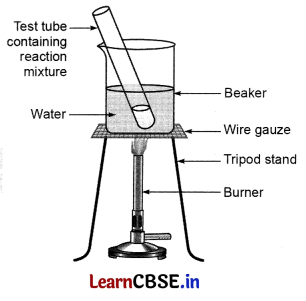
OR
Difference between soaps and detergents:
| soaps | Detergents |
| (i) Soaps are the sodium or potassium salts of long chain carboxylic acids. The ionic group in soaps is: COO – Na + | (i) Detergents are the sodium salts of long chain benzene sulphonic acids or long chain alkyl sulphates. The ionic group in a detergent is: – SO 3 – Na + or – SO4 – Na + |
| (ii) Soaps are biodegradable. | (ii) Some detergents are not biodegradable. |
| (iii) Soaps have relatively weak cleansing action. | (iii) Detergents have a strong cleansing action. |
Action of soap in removing an oily spot from a piece of cloth. Soaps are molecules in which the two ends have differing properties, one is hydrophilic, that is, it dissolves in water, while the other end is hydrophobic, that is, it dissolves in hydrocarbons. When soap is at the surface of water, the hydrophobic ‘tail’ of soap will not be soluble in water and the soap will align along the surface of water with the ionic end in water and the hydrocarbon ‘tail’ protruding out of water. Inside water, these molecules have a unique orientation that keeps the hydrocarbon portion out of the water.
This is achieved by forming clusters of molecules in which the hydrophobic tails are in the interior of the cluster and the ionic ends are on the surface of the cluster. This formation is called a micelle. Soap in the form of a micelle is able to clean, since the oily dirt will be collected in the centre of the micelle. The micelles stay in solution as a colloid and will not come together to precipitate because of ion-ion repulsion. Thus, the dirt suspended in the micelles is also easily rinsed away.
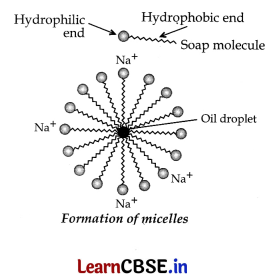
Soaps are not effective when a fabric is washed in hard water. Hardness of water is due to the presence of Ca
2+
and Mg
2+
ions. These ions react with soaps to form white precipitates called scum. This scum sticks to the surface of the clothes and hence soaps are not very effective when a fabric is washed. This problem can be solved by using detergents as they are more soluble in hard water and have better cleansing action.
Question 17.
A person is unable to see objects distinctly placed within 50 cm from his eyes.
(a) Name the defect of vision the person is suffering from and list its tivo possible causes.
(b) Draw a ray diagram to show the defect in the above case.
(c) Mention the type of lens used by him for the correction of the defect and calculate its power. Assume that the near point for the normal eye is 25 cm.
(d) Draw a labelled diagram for the correction of the defect in the above case.
Answer:
(a) Hypermetropia is the defect of vision. This defect arises either because —
(i) The focal length of the eye lens is too long.
(ii) Decrease in the size of the eyeball.

(c) Convex lens can be used to correct this defect
Power (P) = \(\frac { 1 }{ f }\);
Object distance, u = -25 cm;
Focal length = f
Image distance, = -50 cm;
Lens formula, = \(\frac { 1 }{ f }\) = \(\frac { 1 }{ v }\) – \(\frac { 1 }{ u }\)
= \(\frac{1}{-50}\) – \(\frac{1}{-25}\) = \(\frac{-1-(-2)}{50}\) = \(\frac{-1+2}{50}\) = \(\frac{1}{50}\) = 50 cm or 0.5 m
∴ P = \(\frac { 1 }{ f }\) = \(\frac { 1 }{ 0.5 }\) = \(\frac { 10 }{ 5 }\) = 2 D

Question 18.
(a) A student dropped a few pieces of marble in dilute hydrochloric acid contained in a test tube. The evolved gas was passed through lime water. What change would be observed in lime water? Write balanced chemical equations for both the changes observed.
(b) State the chemical property in each case on which the following uses of baking soda are based:
(i) as an antacid.
(ii) as a constituent of baking powder.
Answer:
(a) When a piece of marble (CaCO
3
) is dropped in dil. HCl, CO
2
gas will be evolved which turns lime water milky.

Formation of CaCO
3
white ppt makes the lime water milky.
(b) (i) Being alkaline, sodium hydrogen carbonate (baking soda) neutralises the excess acid present in the stomach and relieves indigestion.
(ii) Baking powder is a mixture of baking soda and a mild edible acid such as tartaric acid. When baking powder mixes with water (present in dough made for baking cake or bread), then sodium hydrogen carbonate reacts with tartaric acid to evolve CO
2
gas.

Question 19.
(a) Define Electric power. An electrical device of resistance R is connected across a source of voltage V and draws a current I. Derive an expression for power in terms of current and resistance.
(b) Two electric bulbs rated 100 W; 220 V and 60 W; 220 V are connected in parallel to an electric mains of 220 V. Find the current drawn by the bulbs from the mains.
OR
(a) How will you infer with the help of an experiment that the same current flows through every part of the circuit containing three resistors R
1
, R
2
and R
3
in series connected to a battery of V volts?
(b) Study the given circuit and find out:
(i) Current in 12 Q resistor.
(ii) Difference in the readings of A
1
and A
2
, if any.
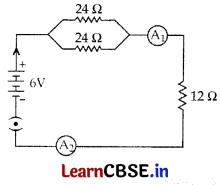
Answer:
(a) Electric Power. Electric Power is the rate at which work is done or energy is transformed in an electrical circuit.
We know that electric work done is,
W = V × I × t
P = \(\frac{V \times I \times t}{t}\)
⇒ P = VI
As per Ohm’s law, V = IR …(i)
Substituting (i) in the power formula
We get,
P = IR × I = I
2
R …. where [I is the current, R is the resistance
(b) Resistance of 1
st
bulb,
R
1
= \(\frac{V^2}{P}\) = \(\frac{220 \times 220}{100}\) = 480 Ω = R
1
Resistance of 2
nd
bulb,
R
2
= \(\frac{V^2}{P}\) = \(\frac{220 \times 220}{60}\) = \(\frac{2420}{3}\) Ω
Total Resistance in Parallel,
\(\frac{1}{R}\) = \(\frac{1}{\mathrm{R}_1}\) + \(\frac{1}{\mathrm{R}_2}\)
\(\frac{1}{R}\) = \(\frac{1}{484}\) + \(\frac{3}{2420}\) = \(\frac{8}{2420}\)
⇒ R = \(\frac{2420}{8}\) Ω
Current drawn by the bulbs from the main line,
I = \(\frac{V}{R}\) = \(\frac{220 \times 8}{2420}\) = \(\frac{8}{11}\) A or 0.73 A
OR
Experiment:
• Construct a series circuit as shown in the figure.
• Measure the potential difference across each resistor by connecting a voltmeter parallel to the resistor.
• Connect the voltmeter so as to read the potential difference across all the resistances (total potential difference).
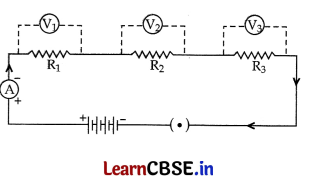
• Record the ammeter reading through each resistor and the total current in the circuit.
• Calculate the equivalent resistances from the reading.
Observation:
• Voltmeter shows different measurements across each resistance as V
1
; V
2
and V
3
across R
1
; R
2
and R
3
respectively.
• But ammeter shows the same reading in all cases.
Conclusion:
Current flowing through all the resistances in series in a circuit is same.
(b) (i) Current through 12 Ω resistor.
I = \(\frac{V}{R}\) = \(\frac{6}{12}\) = \(\frac{1}{2}\) = 0.5 A
(ii) No difference since the ammeters are connected in series, there will be same reading in them.
![]()
Question 20.
(a) Define vegetative propagation. List its two methods.
(b) Why is this mode practised for growing some types of plants?
(c) Explain the process of budding in Hydra with the help of labelled diagram.
OR
What is contraception? List its four different methods. State four reasons for adopting contraceptive methods.
Answer:
(a) Vegetative propagation. The method of obtaining new plants from the parts of old plants like stems, roots and leaves without the help of any reproductive organ.
The two methods of vegetative propagation are –
(i) Natural vegetative propagation and
(ii) Artificial vegetative propagation.
(b) Some plants which do not produce viable seeds or produce seeds with prolonged period of dormancy are cultivated through the mode of vegetative propagation. Thus this method is used for growing of plants bearing superior traits, because they produce generally identical plants.

OR
A number of techniques developed to prevent and control pregnancy is called contraception.
Different methods of contraception:
(i) Barrier methods. In these methods, physical devices such as condoms, diaphragms and cervical caps are used. These devices prevent the entry of sperm in the female genital tract, thus acting as a barrier between them.
(ii) Surgicai methods. There are surgeries that can be carried out in males and females. In males, a small portion of the sperm duct (vas deferens) is blocked by a surgical operation. This prevents the sperms from coming out. In females, a small portion of the fallopian tubes (oviducts) is blocked by a surgical operation. It prevents the egg from reaching the uterus. In both the cases, fertilisation will not take place.
(iii) Chemical methods. This category of contraceptives acts by changing the hormonal balance of the body so that eggs are not released and fertilisation cannot occur. Females use two types of pills for preventing pregnancies, i.e., oral pills and vaginal pills. The oral pills contain hormones which stop the ovaries from releasing ovum into the fallopian tube. This is also called oral contraceptives (OC).
(iv) Intrauterine devices. Other contraceptive devices such as loop or the copper-T are placed in the uterus to prevent pregnancy.
Reasons for adopting contraceptive methods:
- It helps in controlling the size of the family which can improve the standard of living.
- The general health of the female can be improved as reproduction demands high pressure on the body and mind of the female.
- It helps in preventing sexually transmitted diseases.
- These methods check the population growth of a country by controlling child birth rate.
- Frequent and unwanted pregnancies can be avoided by using contraception.
Question 21.
(a) List two visible traits of garden pea that Mendel considered in his experiments. How do Mendel’s experiments show that traits may be dominant of recessive?
(b) With the help of a flow diagram, how would you establish that in human beings the sex of a newborn is purely a matter of chance and none of the parents may be considered responsible for a particular sex of a newborn child.
Answer:
(a) The contrasting visible characters of garden pea plant that Mendel considered were –
(i) Round and wrinkled seeds and (ii) White and violet flowers.
In Mendel’s experiment with pea plants, when he cross-bred a tall pea plant with a short pea plant, he found that the first generation (F
1
) was of only tall plants. In the F
1
progeny, no short plants were obtained. However, in the F
2
generation, both tall and short plants were obtained in the ratio 3 :1 respectively. In the F
2
progeny, both traits tallness and shortness were inherited where the tall character was the dominant trait and short character was the recessive trait. In F
1
generation, short trait was not able to show itself in the presence of tall trait.
This can he depicted by the following Flow Chart:
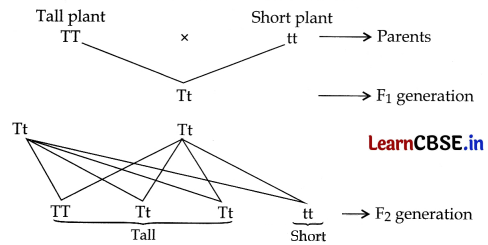
(b)
- There are 23 pairs of chromosomes present in human beings.
- There is 1 pair of sex chromosomes present in human beings.
- The chromosomes which determine the sex of a person are called sex chromosomes. There are two types of sex chromosomes, one is called X chromosome and the other is called Y chromosome. Males contain one X chromosome and one Y chromosome (XY), while females contain two X chromosomes (XX).
Flow chart showing determination of sex of a child:
(i) A male has one X-chromosome and one Y-chromosome. Thus half the male gametes have X-chromosomes and the other half have Y-chromosomes.
(ii) A female has two X-chromosomes. Thus all female gametes have only X-chromosomes.
(iii) If a sperm carrying Y-chromosome fertilises an ovum carrying X-chromosome, then the child born will be a boy.
(iv) If a sperm carrying X-chromosome fertilises an ovum carrying X-chromosome, then the child born will be a girl.
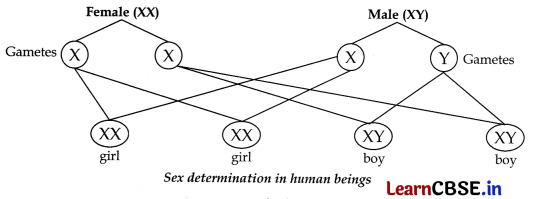
Therefore it is the sperm from the father which determines the sex of the child.
Section – E
Question 22.
A student mixes sodium sulphate powder in barium chloride powder. What change would the student observe on mixing the two powders? Justify your answer and explain how he can obtain the desired change.
OR
(a) Arrange the following metals in the increasing order of their reactivities:
Copper, Zinc, Aluminium and Iron
(b) List two observations you would record in your notebook 30 minutes after adding iron filings to copper sulphate solution.
Answer:
On mixing solution of sodium sulphate and barium chloride, white precipitate of barium sulphate is obtained along with sodium chloride solution.
- 10 ml of solution of sodium sulphate should be taken in test tube.
- 10 ml solution of barium chloride be taken in another test tube.
- Mix the two solutions in a conical flask as shown in the diagram.
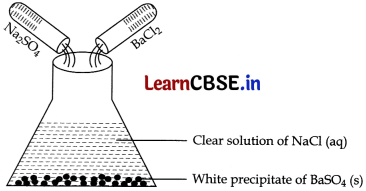
White precipitate of BaSO
4
is formed and there is a clear liquid above the white solid which is NaCl solution. This is a double displacement reaction.
Na
2
SO
4
+ BaCl
2
→ 2NaCl + BaSO
4
OR
(a) Copper < Iron < Zinc < Aluminium
(b) Observations recorded:
- Brown coating on the surface of the iron nail.
- Blue colour of the copper sulphate solution fades away.
Question 23.
A solution ‘X’ gives orange colour when a drop of it falls on pH paper, while another solution ‘Y’ gives bluish colour when a drop of it falls on pH paper. What is the nature of both the solutions? Determine the pH of solutions ‘X’ and ‘Y’.
Answer:
Solution ‘X’ is acidic in nature as it turns into orange colour when a drop of it falls on a pH paper. Its pH value will be in the range of 3 to 5 and is moderately acidic.
Solution ‘Y’ is basic in nature as it turns into blue colour when a drop of it falls on a pH paper. Its pH value ranges from 8 to 11 and is moderately basic.
Question 24.
Study the following ray diagram and list two mistakes committed by the student while tracing it. Rectify these mistakes by drawing the correct ray diagram to show the real position and size of the image corresponding to the position of the object AB.
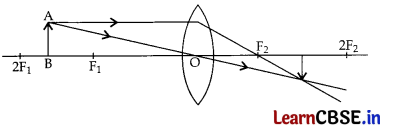
OR
A student has to trace the path of a ray of light through a glass prism. List four precautions he should observe for better results.
Answer:
• The position of F
1
, 2F
1
, F
2
and 2F
2
are not marked properly (accurately). The image should be named A’B’.
• When the object is between F
1
and 2F
1
of a convex mirror, then the image should be beyond 2F
2
which is not drawn correctly.

OR
Precautions to be observed while tracing the path of a ray of light through a glass prism:
- A sharp pencil should be used for drawing the boundary of the glass prism.
- The separation between the two pins should not be less than 5 cm.
- The pin should have sharp tips and fixed vertically.
- Proper arrows should be marked to indicate incident, refracted and emergent ray.
Question 25.
Which one of the following is the correct set-up for studying the dependence of the current on the potential difference across a resistor and why?

Answer:
‘A’ is a correct set-up.
The ammeter must be connected in series between the battery and the resistor. The voltmeter should be put in parallel across the resistor. All the polarities must also be correct.
Set-up ‘A’ satisfies all these, so it is the correct set-up.
![]()
Question 26.
Write four sequential steps of the procedure of experiment “Preparing a temporary mount of a leaf peel to show stomata.”
OR
In the experimental set-up to show that “the germinating seeds give out carbon dioxide.” Answer the following questions:
(i) Why do we keep the conical flask airtight?
(ii) Name the substance kept in the small test tube inside the conical flask. Write its role.
(iii) Why does water rise in the delivery tube?
Answer:
Procedure for preparing a temporary mount of a leaf peel to show stomata:
Step 1. The epidermal peel is taken from a freshly plucked leaf.
Step 2. These pieces are transferred with the help of paint brush into a petridish containing water.
Step 3. The leaf piece is transferred into another watch glass containing a dilute solution of safranin (a red stain).
Step 4. Specimen is transferred back into the petridish containing water to remove excess stain.
Step 5. Specimen is transferred to the slide with the help of a brush.
Step 6. Put a drop of glycerine on the peel and cover it gently with a cover slip by using a needle to avoid any kind of air bubble.
Step 7. Observe the slide under the low-power and high-power magnifications of the compound microscope.
OR
(i) To prevent the escape of the gases (CO
2
) released during germination the conical flask is kept airtight.
(ii) KOH solution is kept in the small test tube. It is used to absorb carbon dioxide.
(iii) Germinating seeds release CO
2
which is absorbed by KOH this creates a partial vacuum which caused the water in the delivery tube to rise.
Question 27.
List two observations on the basis of which it may be concluded that the given slide shows binary fission in Amoeba.
Answer:
(i) Constriction appears and the nucleus elongates and becomes thinner in the middle.
(ii) The nucleus elongates more and more and ultimately divides in two followed by the division of cytoplasm.
These observations give a conclusion that the given slide shows binary fission in Amoeba.
SET – II Code No. 31/4/2
Except for the following questions, all the remaining questions have been asked in Set I.
Section – A
Question 1.
Define current. Give its S.I. unit.
Answer:
Electric current is expressed by the amount of charge flowing through a particular area in unit time.
Its S.I. unit is Ampere (A).
Question 2.
Define ecosystem.
Answer:
The inter relation between biotic components and the abiotic components of a place or an area is known as ecosystem.
Section – B
Question 3.
State laws of refraction of light.
OR
List four characteristics of the image formed by a concave mirror of focal length 40 cm when the object is placed in front of it at a distance of 20 cm from its pole.
Answer:
Laws of refraction of light:
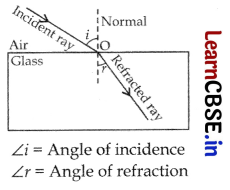
(i) First law. The incident ray, the refracted ray and the normal at the point of incidence, all lie in the same plane.
(ii) Second law. The ratio of sine of angle of incidence to the sine of angle of refraction is constant for a given pair of media. The second law of refraction is called Snell’s law.
Mathematically, it can be written as:
\(\frac { sin i }{ sin r }\) = constant
OR
Characteristics of the image formed by the concave mirror are –
- The image is formed behind the mirror at a distance of 40 cm from the pole.
- It is enlarged.
- It is virtual.
- It is erect.
Question 4.
Draw magnetic field lines in and around a current carrying straight solenoid.
Answer:
Magnetic field lines of current carrying solenoid:
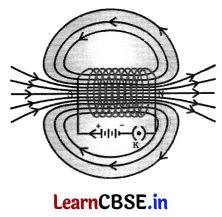
Question 5.
Write the name and molecular formula of a carbon compound having its name suffixed with “-ol” and having two carbon atoms in its molecule. With the help of a chemical equation indicate what happens when this compound is heated with excess conc. H
2
SO
4
.
Answer:
Name of compound. Ethanol; Molecular formula – C
2
H
5
OH
Heating ethanol at 443 K with excess cone, sulphuric acid (H
2
SO
4
) results in the dehydration of ethanol to give ethene.
![]()
The saturated carbon is converted into an unsaturated one.
Section – C
Question 9.
Salt ‘P, commonly used in bakery products, on heating gets converted into another salt ‘Q’, which itself is used for the removal of hardness of water and a gas ‘R’ is evolved. The gas ‘R’ when passed through freshly prepared lime water turns milky. Identify ‘P’, ‘O’ and ‘R’, giving chemical equation for the justification of your answer.
Answer:
When baking soda, NaHCO
3
(used in baking products) is heated or mixed in water the following reaction takes place –
![]()
Sodium carbonate is used to remove hardness of water. The gas evolved is carbon dioxide which turns lime water milky.
Therefore,
Salt ‘P’ is NaHCO
3
(Sodium Hydrogen Carbonate), which is used as baking powder.
Salt ‘Q’ is Na
2
CO
3
(Sodium Carbonate), which is used to remove the hardness of water.
Gas ‘R’ is CO
2
(Carbon dioxide), which turns lime water milky.
Question 12.
The following diagram shows two parallel straight conductors carrying same current. Copy the diagram and draw the pattern of the magnetic field lines around them showing their directions. What is the magnitude of magnetic field at a point ‘X’ which is equidistant from the conductors? Given justification for your answer.
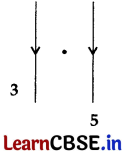
Answer:
In both the parallel straight conductors, the direction of the magnetic field lines will be equal as in both, the current is moving in the same direction.
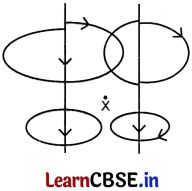
Applying Right-hand thumb rule, we can draw the magnetic field lines around the given wires. As both the wires have a current flowing downward hence the direction of the magnetic field will be clockwise for both of them as shown in figure.
At the point ‘X’ the magnitude of the magnetic field is zero. By applying right hand thumb rule, we know that every section of the wire contributes equal magnetic field lines. Point ‘X’ is at equidistant from both the conductors. Since no two magnetic field lines intersect, the field line appears as a straight line at the point X. So the magnitude will be zero.
Question 15.
What is exploitation of resources with short-term aims? List its four advantages.
Answer:
The exploitation of resources with short-term aims means the consumption of resources in such a way that they can help in achieving the short term goal without the concern for future generations.
The advantages of exploiting resources with short term aims:
- Industrial growth will be fast.
- The percentage of gains will be much higher in comparison to long term aims.
- Capital rotation will be faster.
- It will lead to rapid agricultural development.
Section – D
Question 16.
If we cross pure-bred tall (dominant) pea plants with pure-bred dwarf (recessive) pea plant we get pea plants of F
1
generation. If we now self-cross the pea plants of F
1
generation, then we obtain pea plants of F
2
generation.
(i) What do the plants of F
2
generation look like?
(ii) What is the ratio of tall plants to dwarf plants in F
2
generation?
(iii) State the type of plants not found in F
1
generation but appeared in F
2
generation, mentioning the reason for the same.
Answer:
(i) All the plants in F
1
generation plants appear tall.
(ii) The ratio of the tall plants to dwarf plants in F
2
generation is 3 (tall): 1 (dwarf).
(iii) Dwarf plants do not appear in F
1
generation as dwarfness is the recessive trait. According to Mendel’s Law of Dominance, the trait which expresses itself in the hybrid is called dominant and the other which is unable to express itself is the recessive trait.
Question 18.
(a) Define a universal indicator. Mention its one use.
(b) Solution A gives pink colour when a drop of phenolphthalein indicator is added to it. Solution B gives red colour when a drop of methyl orange is added to it. What type of solutions are A and B and which one of the solutions A and B will have a higher pH value?
(c) Name one salt whose solution has pH more than 7 and one salt whose solution has pH less than 7.
Answer:
(a) Universal indicator is a mixture of many different indicators which gives different colours at different pH values of the entire pH scale. It shows different colours at different concentrations of hydrogen ions in a solution.
(b) Solution A gives pink colour when a drop of phenolphthalein indicator is added, therefore A is a base.
Solution B gives red colour when a drop of methyl orange is added to it, therefore B is an acid.
Hence, solution A will have less concentration of hydrogen ion than B.
Thus, A will have pH more than 7 because pH value of – an acid solution < 7, a base solution > 7 and a neutral solution = 7.
(c) The salts of strong acids and weak bases give acidic solution having pH less than 7.
Example, NH
4
Cl, Ammonium Chloride will have pH less than 7.
The salts of weak acids and strong bases give basic solution having pH more than 7. Example, Na
2
CO
3
, Sodium Carbonate will have pH more than 7.
SET – III Code No. 31/4/3
Except for the following questions, all the remaining questions have been asked in Set I & Set II.
Section – A
Question 1.
Mention the condition under which a current can flow in a conductor.
Answer:
If the electrons are bound to move freely then the current can flow in a conductor.
Question 2.
What is meant by biological magnification?
Answer:
Some harmful chemicals like pesticides, when absorbed by the plants through soil and water, get transferred from first trophic level to the last trophic level of the food chain. As these chemicals are non-degradable, their concentration in the bodies of living organisms at each trophic level progressively increases. This increase in the concentration of harmful chemicals in the body of living organisms at the each trophic level of a food chain is called biological magnification.
Section – B
Question 3.
List four characteristics of the image formed by a convex lens of focal length 20 cm when the object is placed in front of it at a distance of 10 cm from its optical centre.
OR
Define refractive index of a transparent medium. The speed of light in a medium of absolute refractive index 1.5 is 2 × 10
8
ms
-1
. What is the speed of light in vacuum?
Answer:
Characteristics of image formed by the convex lens:
(i) The image will be on the same side of the lens as the object (as the object is between F
1
and O).
(ii) It will be enlarged.
(iii) It will be virtual.
(iv) It will be erect.
OR
The refractive index of medium 2 with respect to medium 1 is given by the ratio of the speed of light in medium 1 and the speed of light in medium 2.
Refractive index (η
21
) = \(\frac { Speed of light in medium 1 }{ Speed of light in medium 2 }\)
Absolute refractive index = 1.5;
Speed of light in medium = 2 × 10
8
m/ s
Speed of light in vacuum = Absolute refractive index × Speed of light in medium
= 1.5 × 2 × 10
8
m/s = 3 × 10
8
m/s
Question 4.
It is established that an electric current through a conductor produces a magnetic field around it. Is there a similar magnetic field produced around a thin beam of moving (i) alpha particles, (ii) neutrons? Justify your answer in each case.
Answer:
In case of movement of a charged particle, the magnetic field is created around the path on which charged particle moves.
(i) Alpha particles being positively charged constitute a current in the direction of motion, therefore magnetic field will be produced around a thin beam of moving alpha particles.
(ii) The neutrons being electrically neutral constitute no current, so no magnetic field will be produced around a thin beam of moving neutrons.
Question 5.
“Conversion of ethanol to ethanoic acid is an oxidation reaction.” Justify this statement giving the relevant equation for the chemical reaction involved.
Answer:

Here ethanol is converted into ethanoic acid in the presence of oxidising agents (such as KMnO
4
or K
2
Cr
2
O
7
). Thus, since the conversion involves the addition of oxygen to ethanol, it is an oxidation reaction.
Section – C
Question 6.
List three roles of forests in conserving the environment. How do the forests get depleted? State two consequences of deforestation on the environment.
Answer:
Role of forests in conserving the environment:
- Forests help in bringing sufficient rainfall by maintaining a perfect water cycle.
- Forests provide habitat to wild animals and birds, so an ecological balance is maintained by preserving the biodiversity.
- Forests help to prevent soil erosion and help in maintaining fertility of the soil.
Forests get slowly depleted by the rapid industrialisation and urbanisation. As the population increases, human needs demand large space for living. This leads to the depletion of forests in many places. Forests also get depleted due to forest fires, overgrazing by animals, etc. The consequences of deforestation will be:
(i) Deforestation affects wildlife, plants and humans in different ways, via soil erosion, water cycle disruption, desertification and habitat loss.
(ii) Deforestation leads to emission of greenhouse gas which contributes to global warming.
![]()
Question 8.
State right-hand thumb rule to determine the direction of magnetic field around a current carrying conductor. Apply this rule to find the direction of magnetic field inside and outside a circular loop of wire lying in the plane of a table and current is flowing through it clockwise.
Answer:
If you are holding a current carrying straight conductor in your right hand such that the thumb points towards the direction of current, Then your fingers will wrap around the conductor in the direction of the field lines of the magnetic field.
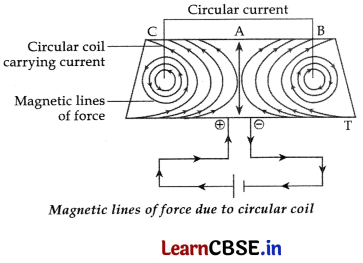
This is known as right hand thumb rule. Since the current passes through the loop in clockwise direction, the front face of the loop will be the south pole and the back face is the face touching the table will be north pole. According to the right-hand rule, the direction of magnetic field inside the loop will be pointing downward. Outside the loop, the direction of the magnetic field will be upward.
Question 10.
A metal X, which is used in thermit process, when heated with oxygen gives an oxide Y which is amphoteric in nature. Identify X and Y. Write balanced chemical equations of the reactions of oxide Y with hydrochloric acid and sodium hydroxide.
Answer:
When aluminium is heated in oxygen it forms aluminium oxide which is amphoteric in nature.
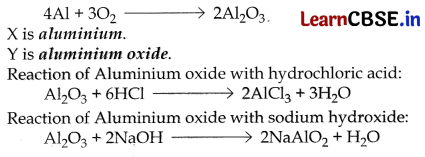
Question 13.
Draw a diagram of human excretory system and label the following:
(i) Urinary bladder
(ii) Left kidney
(iii) Left ureter
Answer:
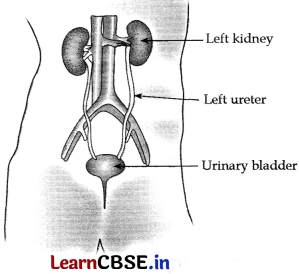
Section – D
Question 17.
(a) What is fragmentation in organisms? Name a multicellular organism which reproduces by this method.
(b) What is regeneration in organisms? Describe regeneration in Planaria with the help of a suitable diagram.
Answer:
(a) Fragmentation. It occurs in multicellular organisms with relatively simple body organisation, for example, in spirogyra (an algae plant). The body breaks up on maturation into two or more smaller pieces and each piece then develops into a new individual.
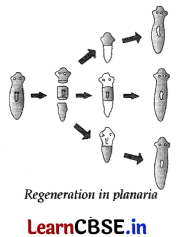
(b) The process of getting back a full organism from its body parts is called regeneration. The simple animals like hydra and planaria show regeneration.
Explanation. If the body of planaria gets cut into a number of . pieces, then each body piece can regenerate into a complete planaria by growing all the missing parts. The regeneration of an organism from its cut body part occurs by the process of growth and development. The cells of cut body part divide rapidly to make a ball of cells. The cells then become specialised to form different types of tissues which again form various organs and body parts.